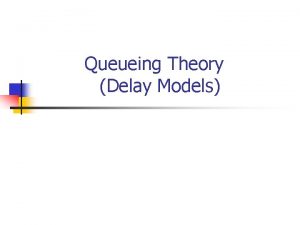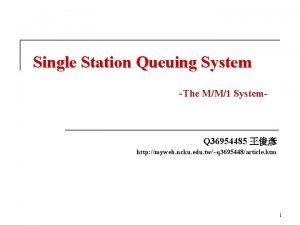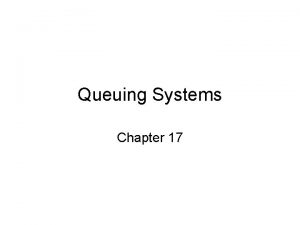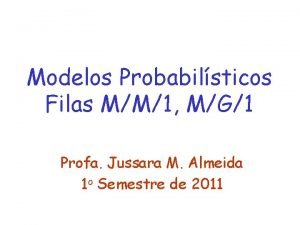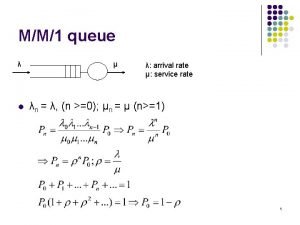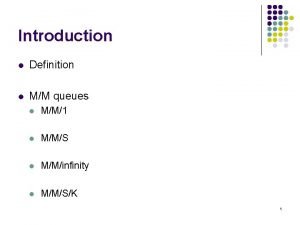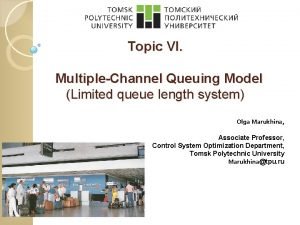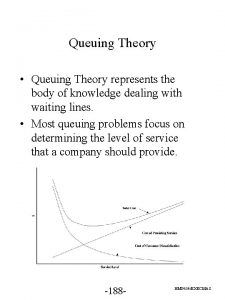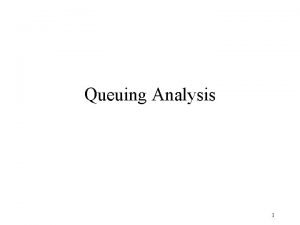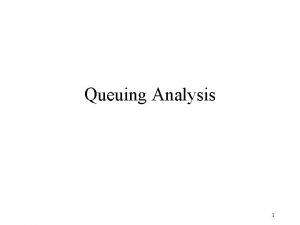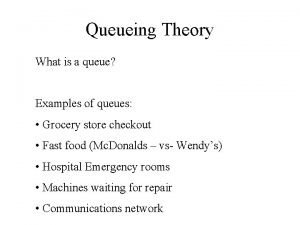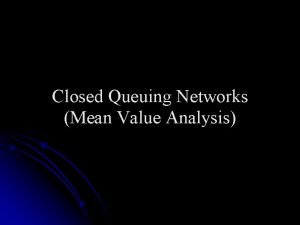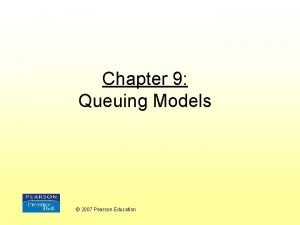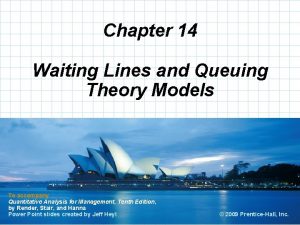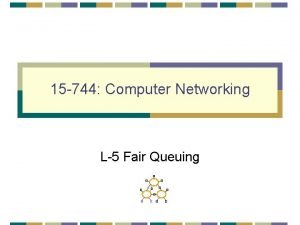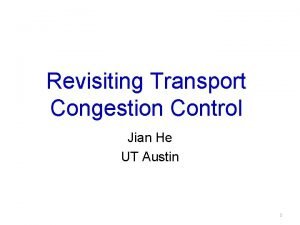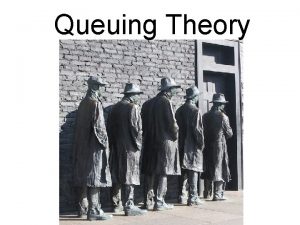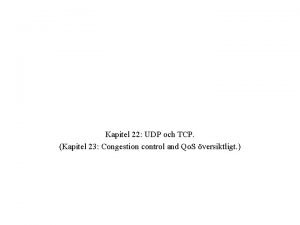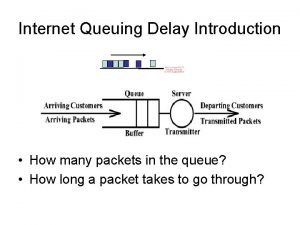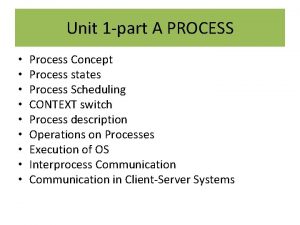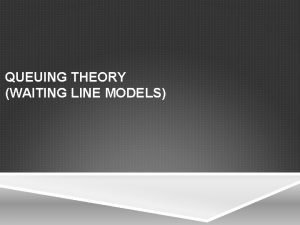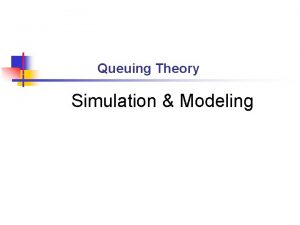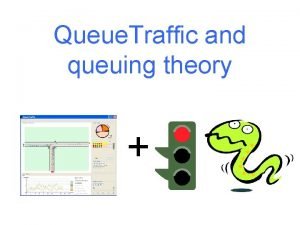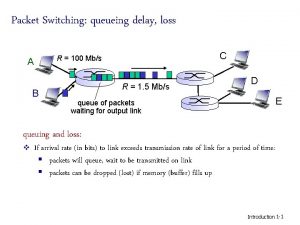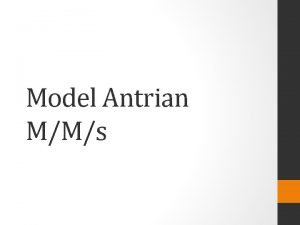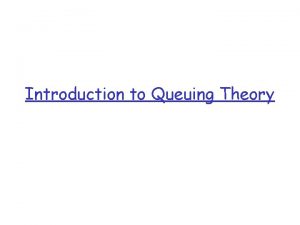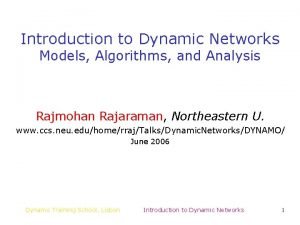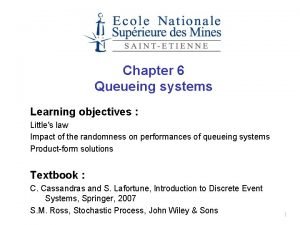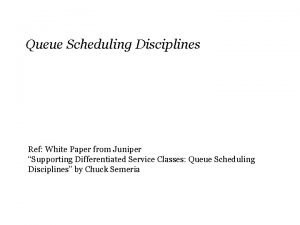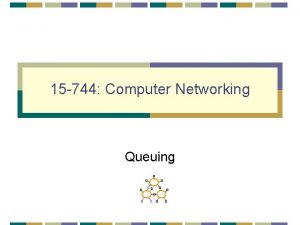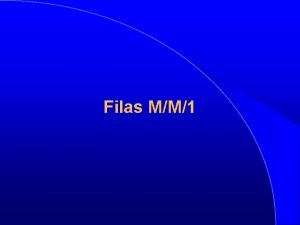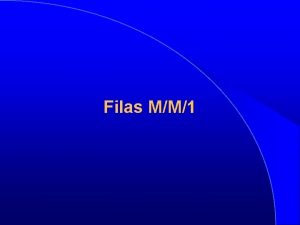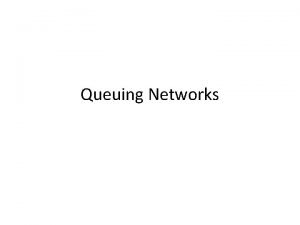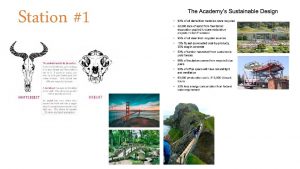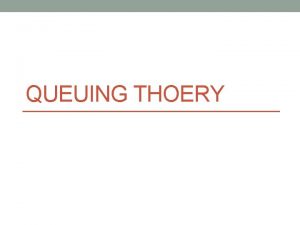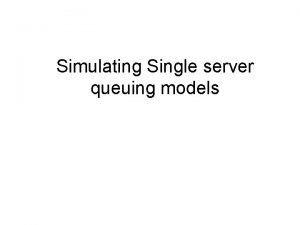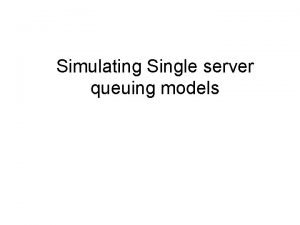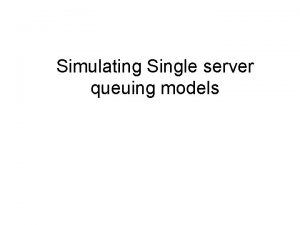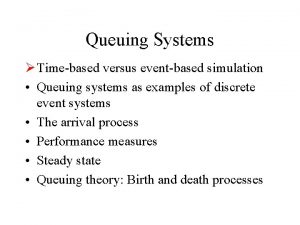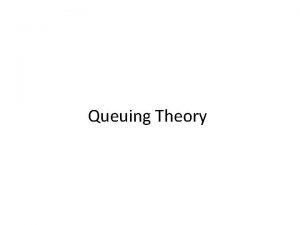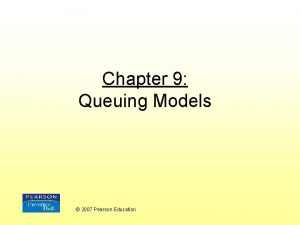Single Station Queuing System The MM1 System Q


































- Slides: 34

Single Station Queuing System -The M/M/1 System- Q 36954485 王俊彥 http: //myweb. ncku. edu. tw/~q 3695448/article. htm 1

Outline n Kendall’s notation 5: 00 q n M/M/1 system 10: 00 q q q n Introduction Parameters setting Performance measures Simulation modeling 15: 00 q q q n Introduction Intuitive explanation C/C++ code Result References 5: 00 2

Kendall’s notation (A/B/m/K – Z) A/B/m/k–Z … servers Queueing Arrival discipline 1 process queue Departing jobs m A Arrival Process B Service Process m Number of Servers k maximum # of customers in the system Z Queueing Discipline Explanation FCFS First-come-first-serviced M Exponential Distribution (memoryless) LCFS Last-come-first-served Ek Erlang Distribution with k phases RR Round-robin Hk Hyper. Exponential with k phases PS Processor sharing D Deterministic Distribution (constant) … Page 211 in textbook G General Distribution 3

Examples of Kendall’s notation n M / m / K -FCFS q n This would describe a queueing system with an exponential distribution for the interarrival times of customers and the service times of customers, m servers, a maximum of K customers in the queueing system at once, and First-come-first-served for queueing discipline. To practice : M/G/5/K-LCFS 4

Performance measure n A queueing model represents a dynamic system, the performance measures vary with time. n Normally, however, we are content with results in steadystate (statistical equilibrium). q q q All transient behavior has ended The system has settled down The values of the performance measures are independent of time 5

Performance measure (cont. ) 6

Performance measure (cont. ) SYSTEM QUEUE servers SERVICE 1 … Arrival process queue Departing jobs m 7

M/M/1 performance measure n Recall that in this case, the arrival process is Poisson, the service times are exponentially distributed, and there is a single server. n The system can be modeled as a birth-death process with birth rate (arrival rate) λ and death rate (service rate) μ. n The birth-death process is in the CH. 3 (eq. 3. 12) 8


Our simulation n For expository convenience, we assume that interarrival and service time of customers are below : A 1=0. 4 , A 2=1. 2 , A 3=0. 5 , A 4=1. 7 , A 5=0. 2 , A 6=1. 6 , A 7=0. 2 , A 8=1. 4 , A 9=1. 9 , …. q q S 1=2. 0 , S 2=0. 7 , S 3=0. 2 , S 4=1. 1 , S 5=3. 7 , S 6=0. 6 , …. q Unit-less 0. 4 1. 2 0. 5 1. 7 0. 2 1. 6 Time (unit) 0 0. 4 1. 6 2. 1 3. 8 4. 0 5. 6 10

Exponential random variable int main( ) // Example in C { double u=0, r=0; int mean=2; srand(time(NULL)); u=(double)(1+rand()%100)/(double)100; r=-mean*log(u); printf("r=%2. 2 fn", r); return 0; } 11

Q(t) and B(t) Q(t) 3 2 1 0 0. 4 1. 6 2. 1 2. 4 3. 1 3. 3 3. 8 4. 0 4. 9 5. 6 5. 8 7. 2 8. 6 departures 0 0. 4 1. 6 2. 1 2. 4 3. 1 3. 3 3. 8 4. 0 4. 9 5. 6 5. 8 7. 2 8. 6 arrivals B(t) 1 0 12

Three quantities 13

Arrive state Depart state 14

Intuitive explanation : t=0 Initialization Time=0 n n n System state A D 0 0 Server status Number in queue Time Of last event Time Of arrival clock 0 0 Number delayed Total delay 0. 4 ∞ Event list 0 0 Area Under Q(t) Under B(t) t=0 : initialization Our modeling assumption was initially the system is empty of customs and the server is idle (idle=0 & busy=1). And number of customs in queue is 0. The event list give the times of next occurrence in A and departure time in D. 15

Intuitive explanation : t=0. 4 Initialization Time=0. 4 n n n System state A D 0. 4 1 0 0. 4 Server status Number in queue Time Of last event Time Of arrival clock 1 0 Number delayed Total delay 1. 6 2. 4 Event list 0 0 Area Under Q(t) Under B(t) Number delayed Server status Event list □ ○ 16

Intuitive explanation : t=1. 6 Initialization Time=1. 6 System state 1. 6 n n n 0. 4 1 1 1. 6 Server status Number in queue Time Of last event Time Of arrival A D clock 1 0 Number delayed Total delay 2. 1 2. 4 Event list 0 1. 2 Area Under Q(t) Under B(t) Area under B(t) Number in queue Time of arrival 17

Intuitive explanation : t=2. 1 Initialization Time=2. 1 System state 0. 4 1 2 1. 6 Server status Number in queue 2. 1 n 1. 6 2. 1 Time Of arrival A D 2. 1 clock 2. 1 Time Of last event 1 0 Number delayed Total delay 3. 8 2. 4 Event list 0. 5 1. 7 Area Under Q(t) Under B(t) Area under Q(t) 18

Intuitive explanation : t=2. 4 Initialization Time=2. 4 System state 2. 4 2. 1 n n 1. 6 1 1 2. 4 2. 1 Server status Number in queue Time Of last event Time Of arrival clock 2 0. 8 Number delayed Total delay A D 3. 8 3. 1 Event list 1. 1 2. 0 Area Under Q(t) Under B(t) Number delayed Total delay 19

Intuitive explanation : t=3. 1 & t=3. 3 Initialization Time=3. 1 2. 1 System state 3. 1 1 0 3. 1 Server status Number in queue Time Of last event Initialization Time=3. 3 Time Of arrival clock 3 1. 8 Number delayed Total delay System state 3. 3 0 0 3. 3 Server status Number in queue Time Of last event Time Of arrival A D clock 3 1. 8 Number delayed Total delay 3. 8 3. 3 Event list 1. 8 2. 7 Area Under Q(t) Under B(t) A D 0. 4 ∞ Event list 1. 8 2. 9 Area Under Q(t) Under B(t) 20

Intuitive explanation : t=3. 8 & t=4. 0 Initialization Time=3. 8 System state 3. 8 1 0 3. 8 Server status Number in queue Time Of last event Initialization Time=4. 0 Time Of arrival clock 4 1. 8 Number delayed Total delay System state 4. 0 3. 8 1 1 4. 0 Server status Number in queue Time Of last event Time Of arrival A D clock 4 1. 8 Number delayed Total delay 4. 0 4. 9 Event list 1. 8 2. 9 Area Under Q(t) Under B(t) A D 5. 6 4. 9 Event list 1. 8 3. 1 Area Under Q(t) Under B(t) 21

Intuitive explanation : t=4. 9 & t=5. 6 Initialization Time=4. 9 4. 0 System state 4. 9 1 0 4. 9 Server status Number in queue Time Of last event Initialization Time=5. 6 Time Of arrival clock 5 2. 7 Number delayed Total delay System state 5. 6 4. 0 1 1 5. 6 Server status Number in queue Time Of last event Time Of arrival A D clock 5 2. 7 Number delayed Total delay 5. 6 8. 6 Event list 2. 7 4. 0 Area Under Q(t) Under B(t) A D 5. 8 8. 6 Event list 2. 7 4. 7 Area Under Q(t) Under B(t) 22

Intuitive explanation : t=5. 8 & t=7. 2 Initialization Time=5. 8 System state 4. 0 1 2 5. 6 Server status Number in queue 5. 8 Initialization Time=7. 2 4. 0 5. 6 5. 8 7. 2 5. 6 5. 8 Time Of arrival 5. 8 clock 5. 8 Time Of last event 5 2. 7 Number delayed Total delay System state 1 3 Server status Number in queue 5. 6 5. 8 7. 2 Time Of arrival 7. 2 clock 7. 2 Time Of last event A D 5 2. 7 Number delayed Total delay 7. 2 8. 6 Event list 2. 9 4. 9 Area Under Q(t) Under B(t) A D 9. 1 8. 6 Event list 5. 7 6. 3 Area Under Q(t) Under B(t) 23

Intuitive explanation : t=8. 6 Initialization Time=8. 6 System state 5. 6 1 2 5. 8 Server status Number in queue 7. 2 5. 8 7. 2 Time Of arrival 8. 6 clock 8. 6 Time Of last event 6 5. 7 Number delayed Total delay A D 9. 1 9. 2 Event list 9. 9 7. 7 Area Under Q(t) Under B(t) 24

C/C++ code – include & parameters #include <stdio. h> #include <math. h> #include "lcgrand. h" /* Header file for random-number generator. */ #define Q_LIMIT 100 /* Limit on queue length. */ #define BUSY 1 /* Mnemonics for server's being busy */ #define IDLE 0 /* and idle. */ int next_event_type, num_custs_delayed, num_delays_required, num_events, num_in_q, server_status; float area_num_in_q, area_server_status, mean_interarrival, mean_service, sim_time, time_arrival[Q_LIMIT + 1], time_last_event, time_next_event[3], total_of_delays; FILE *infile, *outfile; void initialize(void); void timing(void); void arrive(void); void depart(void); void report(void); void update_time_avg_stats(void); float expon(float mean); 25

C/C++ code – main function main() /* Main function. */ { infile = fopen("mm 1. in", "r"); outfile = fopen("mm 1. out", "w"); num_events = 2; initialize( ); while (num_custs_delayed < num_delays_required) { timing( ); update_time_avg_stats( ); switch (next_event_type) { case 1: arrive( ); break; case 2: depart( ); break; } } report( ); fclose(infile); fclose(outfile); return 0; } 26

C/C++ code – initialize function void initialize(void) /* Initialization function. */ { sim_time = 0. 0; server_status = IDLE; num_in_q = 0; time_last_event = 0. 0; /* Initialize the statistical counters. */ num_custs_delayed = 0; total_of_delays = 0. 0; area_num_in_q = 0. 0; area_server_status = 0. 0; /* Initialize event list. Since no customers are present, the departure (service completion) event is eliminated from consideration. */ time_next_event[1] = sim_time + expon(mean_interarrival); time_next_event[2] = 1. 0 e+30; } 27

C/C++ code – timing function void timing(void) /* Timing function. */ { int i; float min_time_next_event = 1. 0 e+29; next_event_type = 0; for (i = 1; i <= num_events; ++i) if (time_next_event[i] < min_time_next_event) { min_time_next_event = time_next_event[i]; next_event_type = i; } if (next_event_type == 0) { fprintf(outfile, "n. Event list empty at time %f", sim_time); exit(1); } sim_time = min_time_next_event; } 28

C/C++ code – arrive function void arrive(void) /* Arrival event function. */ { float delay; time_next_event[1] = sim_time + expon(mean_interarrival); if (server_status == BUSY) { ++num_in_q; if (num_in_q > Q_LIMIT) { fprintf(outfile, "n. Overflow of the array time_arrival at"); fprintf(outfile, " time %f", sim_time); exit(2); } time_arrival[num_in_q] = sim_time; } else { delay = 0. 0; total_of_delays += delay; ++num_custs_delayed; server_status = BUSY; time_next_event[2] = sim_time + expon(mean_service); } } 29

C/C++ code – depart function void depart(void) /* Departure event function. */ { int i; float delay; if (num_in_q == 0) { server_status = IDLE; time_next_event[2] = 1. 0 e+30; } else { --num_in_q; delay = sim_time - time_arrival[1]; total_of_delays += delay; ++num_custs_delayed; time_next_event[2] = sim_time + expon(mean_service); for (i = 1; i <= num_in_q; ++i) time_arrival[i] = time_arrival[i + 1]; } } 30

Arrive state Depart state 31

C/C++ code – update_time_avg_state & expon function void update_time_avg_stats(void) { float time_since_last_event; time_since_last_event = sim_time - time_last_event; time_last_event = sim_time; area_num_in_q += num_in_q * time_since_last_event; area_server_status += server_status * time_since_last_event; } float expon(float mean) /* Exponential variate generation function. */ { /* Return an exponential random variate with mean "mean". */ float u; u=rand (1); return -mean * log(u); } 32

References n Java q http: //www. nirarebakun. com/queue/emati. html q n C/C++ & FORTRAN q http: //www. mhhe. com/engcs/industrial/lawkelton/index. mhtml 33

Q&A http: //myweb. ncku. edu. tw/~q 3695448/article. htm 34
 Mm1 system
Mm1 system Kendall's notation
Kendall's notation Components of queuing system
Components of queuing system Modelo mm1k
Modelo mm1k Queue waiting time
Queue waiting time M/m/1 queue
M/m/1 queue Multi channel queuing model
Multi channel queuing model Queueing theory
Queueing theory Queue waiting time
Queue waiting time Queuing analysis examples
Queuing analysis examples Queuing theory formula
Queuing theory formula Queueing theory
Queueing theory Closed queuing network
Closed queuing network Kendall's notation
Kendall's notation Constant service time model
Constant service time model Queuing discipline in computer networks
Queuing discipline in computer networks Queuing delay
Queuing delay Rtt
Rtt Queuing theory calculator
Queuing theory calculator Tcp udp
Tcp udp Queuing delay
Queuing delay Queuing delay
Queuing delay Fair queuing
Fair queuing What is process concept
What is process concept At a certain petrol pump customers arrive
At a certain petrol pump customers arrive Queuing theory simulation
Queuing theory simulation Queuing theory
Queuing theory Queuing delay in packet switching
Queuing delay in packet switching Mms queuing model
Mms queuing model Queuing theory definition
Queuing theory definition Queuing theory
Queuing theory Cucm mixed mode
Cucm mixed mode Queuing theory little's law
Queuing theory little's law Priority queuing
Priority queuing Oci message queue
Oci message queue
